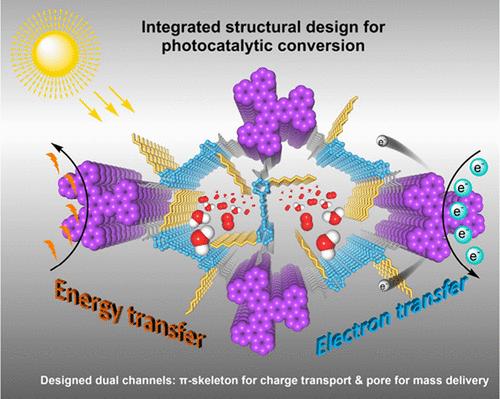当前位置:
X-MOL 学术
›
Acc. Chem. Res.
›
论文详情
Our official English website, www.x-mol.net, welcomes your
feedback! (Note: you will need to create a separate account there.)
Photocatalysis with Covalent Organic Frameworks
Accounts of Chemical Research ( IF 16.4 ) Pub Date : 2024-10-07 , DOI: 10.1021/acs.accounts.4c00517 Yongzhi Chen, Donglin Jiang
Accounts of Chemical Research ( IF 16.4 ) Pub Date : 2024-10-07 , DOI: 10.1021/acs.accounts.4c00517 Yongzhi Chen, Donglin Jiang

|
Utilizing light to enable chemical conversions presents a green and sustainable approach to produce fuels and chemicals, and photocatalysis is one of the key chemical technologies that needs to be well developed in this century. Despite continuous progress in the advancement of various photocatalysts based on small inorganic and organic compounds, polymers, and networks, designing and constructing photocatalysts that combine activity, selectivity, and reusability remains a challenging goal. For catalytic activity, the difficulty originates from the complexity of photochemical reactions, where the light-harvesting system, multielectron and multihole-involving processes, and pinpoint mass delivery simultaneously need to be established in the system. For selectivity, the difficulty stems from the elaborate design of catalytic sites and space, especially their orbital energy levels, spatial arrangement, and environment; developing a molecular strategy that enables an overall design and control of these factors of different aspects is necessary yet arduous. For reusability, the difficulty arises from the stability and recyclability of the photocatalysts upon continuous operation under photoredox reaction conditions. How to recover photocatalysts in an energy-saving way to enable their cyclic use while retaining activity and selectivity is at the core of this problem. These bottleneck issues reflect that molecular design of a photocatalyst is not a simple summation of the above requirements, but a systematic scheme that can organically interlock various aspects is needed.
中文翻译:

使用共价有机框架进行光催化
利用光来实现化学转化是一种绿色和可持续的燃料和化学品生产方法,而光催化是本世纪需要充分发展的关键化学技术之一。尽管基于小的无机和有机化合物、聚合物和网络的各种光催化剂在进步方面不断取得进展,但设计和构建兼具活性、选择性和可重用性的光催化剂仍然是一个具有挑战性的目标。对于催化活性,困难源于光化学反应的复杂性,其中需要在系统中同时建立光捕获系统、多电子和多孔参与过程以及精确质量传递。对于选择性,困难源于催化位点和空间的精心设计,尤其是它们的轨道能级、空间布置和环境;开发一种分子策略,能够对不同方面的这些因素进行整体设计和控制是必要的,但也是艰巨的。对于可重复使用性,困难在于光催化剂在光氧化还原反应条件下连续运行时的稳定性和可回收性。如何以节能的方式回收光催化剂以实现其循环使用,同时保持活性和选择性是这个问题的核心。这些瓶颈问题反映了光催化剂的分子设计并不是上述要求的简单总结,而是需要一个能够有机地环环相扣的系统方案。
更新日期:2024-10-07
中文翻译:

使用共价有机框架进行光催化
利用光来实现化学转化是一种绿色和可持续的燃料和化学品生产方法,而光催化是本世纪需要充分发展的关键化学技术之一。尽管基于小的无机和有机化合物、聚合物和网络的各种光催化剂在进步方面不断取得进展,但设计和构建兼具活性、选择性和可重用性的光催化剂仍然是一个具有挑战性的目标。对于催化活性,困难源于光化学反应的复杂性,其中需要在系统中同时建立光捕获系统、多电子和多孔参与过程以及精确质量传递。对于选择性,困难源于催化位点和空间的精心设计,尤其是它们的轨道能级、空间布置和环境;开发一种分子策略,能够对不同方面的这些因素进行整体设计和控制是必要的,但也是艰巨的。对于可重复使用性,困难在于光催化剂在光氧化还原反应条件下连续运行时的稳定性和可回收性。如何以节能的方式回收光催化剂以实现其循环使用,同时保持活性和选择性是这个问题的核心。这些瓶颈问题反映了光催化剂的分子设计并不是上述要求的简单总结,而是需要一个能够有机地环环相扣的系统方案。






























 京公网安备 11010802027423号
京公网安备 11010802027423号